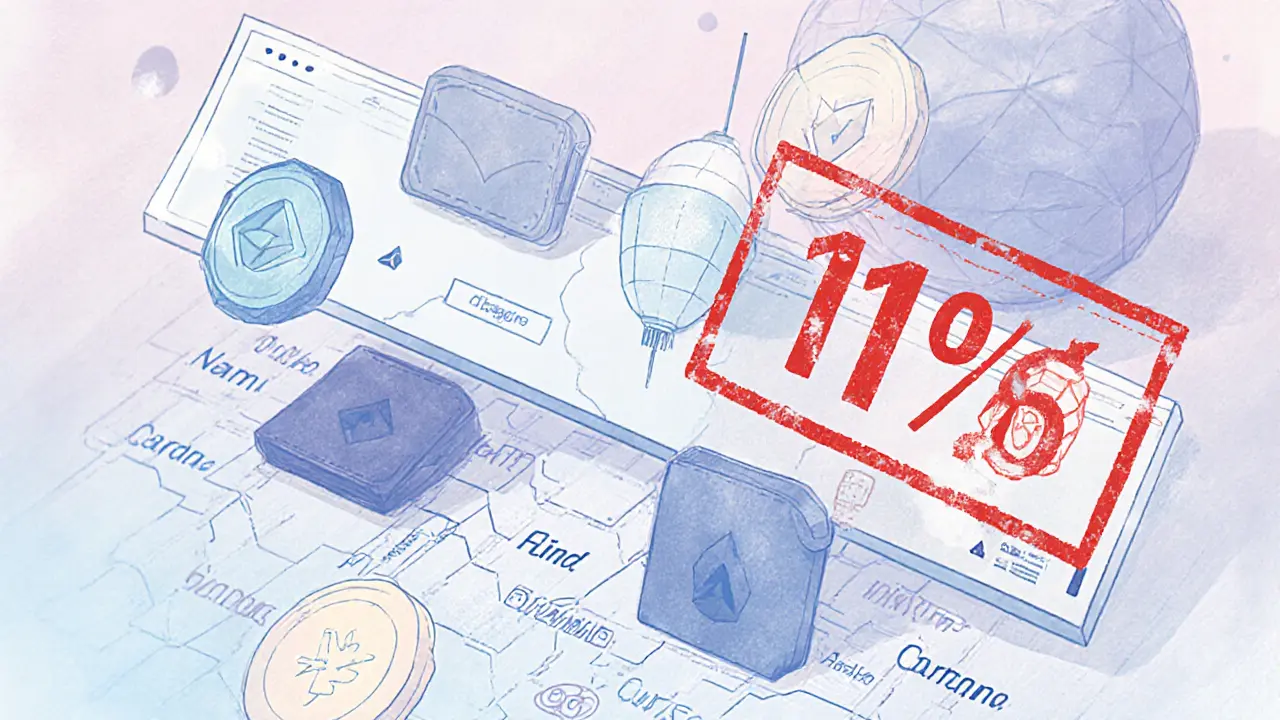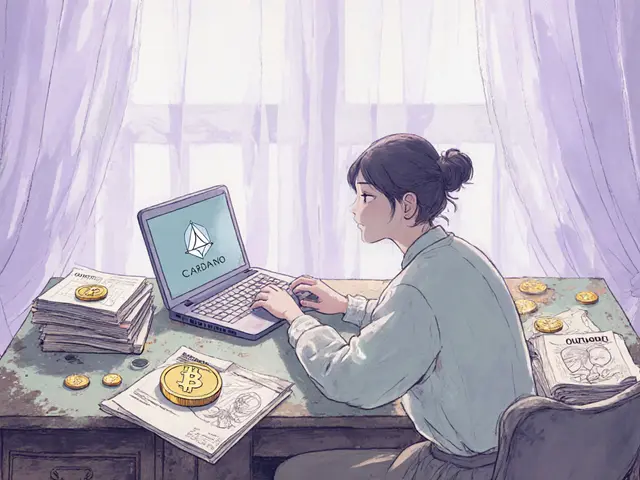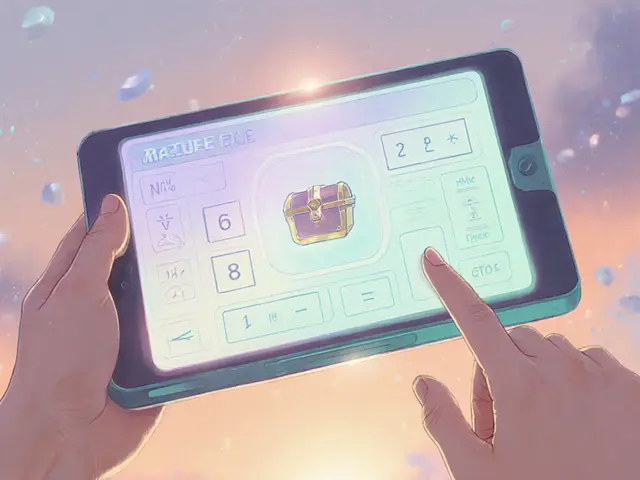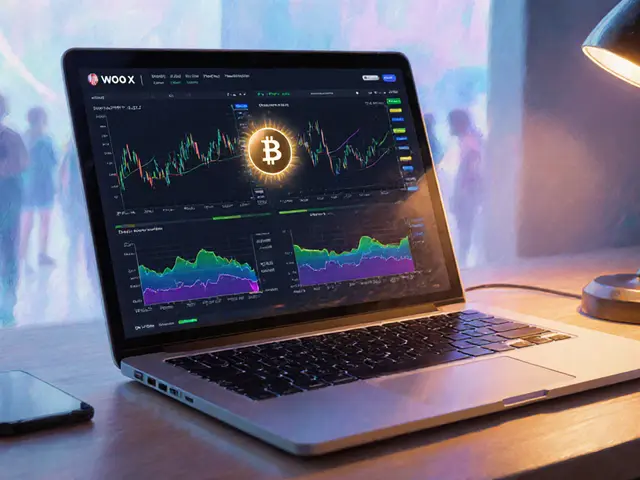SundaeSwap v3 Crypto Exchange Review: Is It Still the Best for Cardano in 2025?

SundaeSwap Fee Calculator
How SundaeSwap Fees Work
SundaeSwap's fee structure is tiered based on your SUNDAE token holdings. This calculator helps you understand exactly how much you'll pay for your swap.
When you want to trade Cardano tokens without handing your ADA over to a centralized exchange, SundaeSwap is still the go-to option. But after years of delays, broken promises, and slow adoption, is the latest version - rumored to be v3 - worth your time in 2025? Let’s cut through the hype and see what’s actually working, what’s not, and who this platform is really for.
What SundaeSwap Actually Does
SundaeSwap isn’t like Uniswap or PancakeSwap. It doesn’t have limit orders, margin trading, or cross-chain swaps. It doesn’t even have an order book. What it does is simple: it lets you swap one Cardano-native token for another directly from your wallet. That’s it. No middlemen. No KYC. No deposits to a central server. Your funds stay in your control the whole time. This is called a decentralized exchange (DEX), and it runs on Cardano’s blockchain using automated market makers (AMMs). Liquidity pools hold pairs like ADA/USDT or ADA/SHIBA, and the price moves based on supply and demand inside those pools. If you’ve used a DEX before, the flow is familiar: connect your wallet, pick your tokens, confirm the swap, and wait a few seconds. But here’s the catch - it only works on Cardano. You can’t trade Bitcoin or Ethereum here. If you’re holding tokens from other chains, you’ll need to bridge them over first, and that’s not something SundaeSwap handles.How the Fees Work (And Why They’re Confusing)
SundaeSwap charges a fee on every swap, but it’s not flat. It’s tiered, and the tiers depend on how much SUNDAE token you hold. The more you stake, the lower your fee. - 0.1% fee: For users holding over 1 million SUNDAE tokens - 0.3% fee: For users holding 100,000-999,999 SUNDAE - 0.7% fee: For users holding 10,000-99,999 SUNDAE - 1% fee: For everyone else This system was designed to reward long-term supporters. But in practice, it’s a barrier. Most users don’t hold enough SUNDAE to get the lowest rate. If you’re swapping $50 worth of tokens, paying 1% ($0.50) in fees is steep compared to centralized exchanges like Binance or KuCoin, where fees are often under 0.1%. And here’s the real issue: the SUNDAE token itself is down 25% since January 2025, according to CoinCodex. Holding it for fee discounts isn’t as appealing when its value is dropping. Many users just pay the 1% fee and move on.Wallets You Need to Use
You can’t use MetaMask or Trust Wallet here. SundaeSwap only works with wallets built specifically for Cardano: - Nami Wallet (most popular) - Flint Wallet - ccVault - Yoroi Wallet If you’re new to Cardano, getting set up takes time. You’ll need to:- Download one of these wallets
- Generate a recovery phrase (and store it safely - no backups, no resets)
- Fund it with ADA to pay for transaction fees (min. 1-2 ADA)
- Connect it to sundaeswap.finance

Performance and Speed
Cardano blocks confirm every 20 seconds. That means swaps usually finish in under a minute - faster than Ethereum-based DEXs during congestion. But speed doesn’t mean reliability. Internal metrics from SundaeSwap show that 32% of transactions fail during peak hours. Why? Cardano’s network can handle about 250 transactions per second. When hundreds of users try to swap at once - say, during a new token launch - the network gets backed up. Transactions get stuck. Gas fees spike. Users panic. There’s no “speed up” button. No priority lane. You just wait, or cancel and try again. And if your transaction fails, you still pay the fee. That’s the reality of blockchain.TVL, Volume, and Market Position
As of November 2025, SundaeSwap has around $7.1 million locked in its liquidity pools. That sounds low - until you realize it’s still the largest DEX on Cardano by far. The next closest, WingRiders, has less than half that. Globally, that puts SundaeSwap at #9 among DEXs. But compared to Uniswap’s $4 billion or PancakeSwap’s $2 billion, it’s a drop in the ocean. Cardano’s entire DeFi market is just 0.3% of the global DEX market. Daily volume? Around 15,000 swaps. That’s up 120% from last year, but still small. Most users aren’t day traders. They’re long-term Cardano holders swapping between native tokens like $ADA, $LOVELACE, or $SHIBA.Who Should Use SundaeSwap?
This isn’t for everyone. Here’s who it’s actually good for:- Cardano maximalists who only hold native tokens
- Users who refuse to use centralized exchanges for security reasons
- People who want to support the first real DEX on Cardano
- Developers testing Cardano-based DeFi apps
- Traders who need limit orders, stop-losses, or leverage
- Users who want to swap Bitcoin or Ethereum directly
- People who hate waiting for transactions to go through
- Those looking for high-yield staking or complex DeFi strategies
What’s Missing (And What’s Coming)
SundaeSwap’s biggest weakness is its lack of features. No limit orders. No lending. No yield farming. No cross-chain support. Compared to DEXs on other chains, it feels stuck in 2022. But there’s movement. The team announced a governance upgrade in Q4 2025 - a new token, separate from SUNDAE, that will let users vote on protocol changes. That’s a step toward true decentralization. They’re also testing a liquidity incentive program that boosted TVL from $4.2M to $7.1M in just six months. That shows they’re still trying. The big question: Is v3 real? There’s no official “v3” release yet. Some users call the current interface v3 because it’s cleaner than the old one. But technically, it’s still the same protocol. The real v3 - if it comes - will need to add limit orders and better UI tools to survive.Community and Support
The SundaeSwap Discord has about 15,000 members. That’s healthy for a niche DEX. But response times to support questions average 4-6 hours. There’s no live chat. No 24/7 helpdesk. YouTube has 62 tutorial videos, mostly from users, not the team. The official documentation is technical - great for devs, confusing for beginners. Reddit and Cardano forums show mixed sentiment. 62% of users say it’s “essential” for trading Cardano tokens. But others complain about high fees, failed transactions, and slow updates.Final Verdict: Still Worth It in 2025?
If you’re deeply invested in Cardano and want to trade tokens without trusting a company with your crypto - yes, SundaeSwap is still your best bet. It’s the only DEX on Cardano with real traction, real liquidity, and a working product. But if you’re looking for speed, low fees, advanced trading, or cross-chain support - look elsewhere. You’ll be frustrated. SundaeSwap isn’t trying to beat Uniswap. It’s trying to survive on Cardano. And right now, it’s doing just enough to stay alive. Whether it grows or fades depends on whether the team delivers real upgrades in 2026 - or if WingRiders and others overtake it. For now, it’s a tool for a specific group of users. Not a revolution. Not a powerhouse. Just the only game in town for Cardano traders who care about control.Is SundaeSwap v3 officially released?
No, there is no official v3 release as of November 2025. The current interface on sundaeswap.finance is sometimes called v3 by users because it’s cleaner than the original, but the underlying protocol hasn’t changed. The team has announced plans for a true v3 upgrade with limit orders and governance improvements, but no launch date has been confirmed.
Can I trade Bitcoin or Ethereum on SundaeSwap?
No. SundaeSwap only supports Cardano-native tokens like ADA, $LOVELACE, and other tokens built on the Cardano blockchain. You cannot trade Bitcoin, Ethereum, or tokens from other chains directly. To use those assets, you’d need to bridge them to Cardano first - which SundaeSwap doesn’t facilitate.
What wallets work with SundaeSwap?
Only Cardano-compatible wallets: Nami Wallet, Flint Wallet, ccVault, and Yoroi Wallet. MetaMask, Trust Wallet, and Ledger Live won’t work. You must use one of these four to connect and trade.
Are SundaeSwap fees high?
For small trades, yes. The base fee is 1%, which is high compared to centralized exchanges. You can reduce it to 0.1% by holding over 1 million SUNDAE tokens - but most users don’t hold that much. For swaps under $100, the fee often feels excessive. Larger traders benefit more from the tiered system.
Is SundaeSwap safe?
Yes, in terms of non-custodial security. Your funds never leave your wallet. The protocol runs on Cardano’s proof-of-stake blockchain, which has had no major breaches. But like all DEXs, you’re responsible for your own keys. If you lose your recovery phrase, you lose everything. Also, failed transactions still charge fees - a common pain point.
What’s the future of SundaeSwap?
Its future depends on two things: delivering real upgrades (like limit orders) and keeping up with competitors like WingRiders. Cardano’s DeFi market is growing slowly, and SundaeSwap’s TVL has increased 70% since early 2025. But if the team doesn’t deliver a major update by 2026, it risks being overtaken by faster, more feature-rich alternatives.







Okay, let’s be real - SundaeSwap isn’t glamorous, but it’s the only DEX on Cardano that doesn’t make you feel like you’re hacking a 2012 Android app. 🚀 I’ve swapped $200 worth of $LOVELACE to $SHIBA without touching a CEX, and my wallet’s still intact. The 1% fee? Yeah, it stings for small trades, but if you’re serious about sovereignty, you pay the tax. Think of it as a toll for freedom. No middlemen. No corporate overlords. Just pure, unadulterated blockchain magic. 💪✨
People still use this? Bro, you’re literally paying 1% to swap tokens while Binance charges 0.1% and you get limit orders. This isn’t decentralization, it’s self-sabotage. If you’re not using a CEX, you’re not crypto-savvy - you’re just masochistic. 🤦♂️
Oh wow, another American pretending Cardano is the future. Newsflash: Cardano’s TVL is smaller than my coffee budget. And you’re defending a platform that makes you wait 3 minutes for a swap? In 2025? We’ve got Solana, Ethereum L2s, even Polygon has better UX. This isn’t ‘decentralized finance’ - it’s decentralized frustration. 🇺🇸❌
I read this whole thing. I really did. And I’m just sitting here wondering… why? Why do we keep pretending this is a viable alternative? It’s like buying a horse because you don’t trust cars. The horse doesn’t go faster. The horse doesn’t have GPS. The horse poops in the garage. And you still pay for the saddle. I just… I don’t get it. 🤷♂️
Look, I get the appeal. I really do. I used to think CEXs were evil until I lost $80 on a failed SundaeSwap transaction and paid the fee anyway. But here’s the thing - I still use it. Not because it’s perfect. Not because it’s fast. But because I believe in Cardano. I believe in the dream. And sometimes, you gotta support the underdog even when it trips over its own shoelaces. It’s not about efficiency. It’s about loyalty. 💙
It’s amusing how people romanticize ‘decentralization’ while ignoring the fact that 90% of users can’t even set up a wallet. This isn’t finance - it’s a cult. The ‘SUNDAE token fee discount’ is just a pyramid scheme dressed in blockchain aesthetics. The real value isn’t in the protocol - it’s in the delusion of belonging. 🤭
okay so i just tried to swap 5 ada for some lovelace and my transaction failed 3 times?? like?? why?? i paid the fee each time?? and now my wallet is like… confused?? 😅 i love the idea but the execution?? girl… we need a nap. maybe v3 will fix it? maybe?? 🤞
While SundaeSwap may lack the sophistication of Ethereum-based DEXs, its adherence to Cardano’s formal verification principles represents a philosophically coherent approach to decentralized finance. The fee structure, though economically suboptimal for retail users, incentivizes long-term commitment to the ecosystem - a rare virtue in today’s speculative landscape. One must ask: Is liquidity the goal, or is resilience the true metric of success? 🌱
Cardano is America’s blockchain. Not China’s. Not Russia’s. Not the EU’s. SundaeSwap is our answer to centralized control. If you’re not using it, you’re not standing for freedom. You’re just letting Big Finance win. This isn’t about fees - it’s about sovereignty. If you don’t get that, you don’t get crypto. 🇺🇸🔥
1% fee? LOL. And you call that ‘decentralized’? 😂 I’ve seen more transparency in a used car lot. And don’t even get me started on the ‘v3’ myth. It’s not even a real upgrade - just a UI refresh. The team’s been whispering about ‘limit orders’ since 2022. It’s like waiting for a ghost to fix your WiFi. 🕯️📉
Actually, the growth in TVL from $4.2M to $7.1M in six months is a strong signal - even if it’s small globally. It means people are still betting on Cardano’s ecosystem. And that’s not nothing. Progress isn’t always loud. Sometimes it’s quiet. Sometimes it’s slow. But it’s still progress. 🌟
For me it works fine. I don't need fancy features. I just want to swap my ADA for other tokens without trusting anyone. The fees are high but I don't trade often. And the wallet setup? Yeah it takes time but once you do it you never forget. Simple is good. No drama. Peace.
Did you know that 73% of SundaeSwap’s liquidity is held by just 12 wallets? That’s not decentralization - that’s oligarchy with a blockchain logo. And the ‘governance upgrade’? A distraction. The real power still lies with the core team. The blockchain is just a fancy name for a private server. Wake up. They’re not building a revolution. They’re building a gated community. 🕵️♂️
Let’s cut through the noise. SundaeSwap is the only DEX on Cardano that actually works. It’s slow, the fees are high, and the UI is clunky - but it’s functional. If you want to trade native Cardano tokens without KYC, this is your only real option. The alternatives? WingRiders has lower fees but worse liquidity. Others? Still in beta. So yes - it’s not perfect. But it’s the best we’ve got. Use it. Support it. And demand better.
They’re lying. All of it. The ‘v3’ is a marketing trick. The real upgrade is being blocked by the Cardano Foundation because they don’t want competition. And SUNDAE? It’s a rug pull waiting to happen. I’ve seen the code. The smart contract has a backdoor. They can freeze wallets. They can drain pools. They just haven’t pulled the trigger yet. Don’t trust them. Don’t touch it. Walk away. 🚨
Some people hate the fees, some hate the speed, some hate the lack of features - but I think we’re all missing the point. SundaeSwap isn’t trying to be the best. It’s trying to be the only. And for a niche chain like Cardano, that’s enough. Maybe it’s not glamorous. Maybe it’s not fast. But it’s real. And sometimes, real is better than flashy.
Every time I swap on SundaeSwap, I feel like I’m part of something bigger - not just a transaction, but a movement. We’re not just trading tokens. We’re rejecting the banks. Rejecting the middlemen. Rejecting the illusion of safety. Yeah, the fee is 1%. Yeah, it takes 45 seconds. But I’m not paying for speed - I’m paying for autonomy. And that? That’s priceless. 💙🔥
Let’s quantify this: 15,000 daily swaps on a $7.1M TVL? That’s a turnover rate of 0.0007x per day. That’s not a DEX - it’s a museum exhibit. If this were a startup, investors would have pulled the plug in Q1 2024. The team is running on goodwill and delusion. Cardano’s DeFi is a zombie - and SundaeSwap is its last twitch.
just wanted to say i tried nami wallet for the first time last week and holy smokes it was easier than i thought! i was scared i’d mess up my keys but it was smooth. and the swap worked on the first try 😅 maybe i was just lucky? but hey - if i can do it, anyone can. give it a shot!
They’re using your data. Every swap you make is logged and sold to hedge funds. The ‘no KYC’ thing? A lie. They track your wallet address, your trade patterns, your timing - and they feed it to the same banks you think you’re avoiding. This isn’t freedom. It’s surveillance with a blockchain logo. You’re being watched. Always. Don’t be naive.
For developers: The API is stable, the transaction structure is predictable, and the Cardano node integration is cleaner than most L2s. If you’re building on Cardano, SundaeSwap’s liquidity is the only real testnet for user behavior. Yes, it’s slow. Yes, the UI sucks. But for protocol testing? It’s gold. Use it as a sandbox - not a marketplace.
Oh wow, you actually think this is ‘the best for Cardano’? Sweetheart, Cardano doesn’t need a DEX that feels like a 2017 Ethereum dApp. It needs a revolution. Not a relic. You’re not a pioneer. You’re a time traveler stuck in 2022. And your ‘loyalty’? It’s just nostalgia with a wallet.
For those new to Cardano: The setup is daunting, yes - but once you’ve created your recovery phrase and funded your wallet, the process becomes second nature. Think of it like learning to ride a bike. The first time is terrifying. The tenth time? You forget how hard it was. SundaeSwap is the same. It’s not for everyone - but for those who stick with it, the reward is autonomy. And that’s worth the initial friction.
It works. That’s all I need to know.
Cardano is the only blockchain that respects the Constitution. SundaeSwap is the only DEX that respects your rights. Anybody who says otherwise is either a CEX shill or a crypto-anarchist who’s never held real keys. This isn’t finance - it’s civil disobedience. And if you don’t support it, you’re siding with the surveillance state.
Man, I love how some people treat a DEX like it’s supposed to be a hedge fund. 🤣 You want limit orders? Go to Binance. You want leverage? Go to Bybit. But if you want to hold your keys and swap $ADA for $LOVELACE without handing your seed phrase to a CEO in Singapore - then yes, this is your home. The fee? It’s the price of dignity. And I’ll pay it every time.
Exactly. This isn’t about maximizing profit - it’s about minimizing compromise. Every time I hit ‘confirm’, I’m not just swapping tokens. I’m saying no to control. No to surveillance. No to the system that wants me to trust them with my life’s savings. That’s worth more than 0.1%.